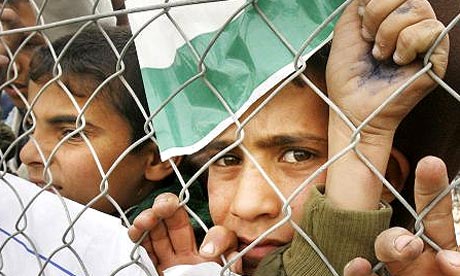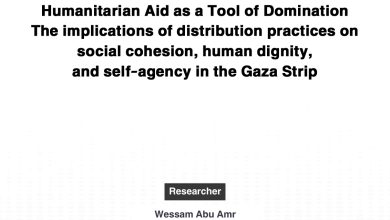Gaza blockade!! How much does it cost!

By: Omar Shaban
The Gaza Strip is 360 Km2, inhabited by 1,700,000, and is part of the Palestinian territories occupied by Israel in 1967. Both the Gaza strip and part of the West Bank have been ruled by the Palestinian Authority since 1994 in virtue of Oslo peace accord. The Israeli army and settlers disengaged from Gaza in August 2005, however Israel is still controlling the boarders, the sea and movement from and into the Gaza Strip. In 2006, the Hamas movement decided to participate for the first time in the 2nd parliamentarian elections taking place in January 2006, where it won the majority of seats of the Palestinian Legislative Council (the Palestinian parliament). The movement formulated the first government in March 2006 but, due to the rejection of the Hamas-led government to abide with the three conditions put by the international community (recognizing the state of Israel; recognizing the previous signed agreements between Israel and PLO; and denouncing violence), the Israeli government and the majority of international community imposed siege and boycott on the Strip.
Imposing blockade in June 2007
In June 2007, when Hamas movement took over the Gaza Strip defeating the Palestinian national authority, Israeli government tightened the siege on the Strip and declared it as a “hostile entity”, which resulted on the following measures taken by the Israeli government;
· Restricting flow of goods and raw material into the Gaza Strip;
· Restricting export of goods from the Gaza Strip;
· Restricting the movements of the people from Gaza to the West Bank and Jerusalem;
· Restricting the movement of the people from Gaza to outside world;
· Denying access to the Gaza Strip‘s land. Territorial water and air space;
· Restricting the transferring of the Israeli currency to the Gaza-based banks.
Consequences and impacts
The blockade have impacted destructively all aspects of life: economy, youth, health, education, social fabrics. The Gaza society became aid-dependent, the private escort witnessed sever deterioration, the education system become disconnected with the rest world, hundreds of patients lost their lives due to lack of better medical treatment and/or restriction on their mobility to travel outside Gaza for further medical treatment. The blockade on the Gaza Strip was eased after the flotilla incident in 31st of May 2010, when the Israeli government allowed the flow of the construction material into Gaza, but only for projects funded by international organizations. UNRWA was permitted to import construction materials to construct 20 new schools, while the total demand is estimated to be 400 news schools. Only 400 commodities are allowed into Gaza while the Gaza Strip was importing more than 7,000 items before June 2007. The Gaza strip is need for more 70,000 new housing units. According to the Palestinian industrial federation (PFI), only 907 industrial firms are operating in the Gaza Strip out of 2,200 industrial firms (41%). The number of worker who is still working at these industrial firms decreased from 51,150 workers in the year 2000 to 12,870 (25%), while the working capacity of these firms is only 29% of its normal capacity. According to Israeli center for freedom of movement (GISHA), there is no shortage of food in Gaza but severs poverty has increased over the years of closure and travel restriction. GISHA estimated that more than 70% of the population receives humanitarian aid. Export from Gaza to Israel is entirely prohibited except for agriculture crops, which is approx. two trucks per day, counting only 1% of the export in the year 2005 .
Since the blockade, the Israeli banks stopped dealing directly with Gaza-based banks. Accordingly, Ramallah-based banks became responsible to transfer the currency to their branches in Gaza Strip; the banking sector in the Gaza Strip faced serious problems in finding enough cash to fulfill its obligations towards their customers, which led to significant decline in the banking services.
The blockade has led to the rapid growth of the tunnels black economy, which became the main source of life to the Gaza population. While the black business is growing, the legitimate business has been shrinking. Recent reports stated that there are more than 850 new millionaires who made huge profit by trading in the tunnels. This has led to the distortion of the social fabrics. The trade volume between Gaza and Israel before the siege was US$ 1,200 Million per year; it dropped down to US$ 200 Millions in 2011. While the trade volume between Gaza and Egypt was US$ 30 Million, it rose up to became US$ 670 Million (tunnels economy). Having in mind that the tunnels business is not legal, do not pay taxes, don’t belief in registration, the new millionaires who made high profit out of the black trading they will be never be members of businessmen associations of chamber of commerce.
The Gaza Chamber of commerce estimated that the Gaza strip loses a million dollars a day as a result of the stringent blockade imposed on Gaza for the last five years in total $2.6 billion. The report emphasized that the above-mention number does not include Israel’s latest war, which had severe consequences on the economy. That war cost Gaza over $1.3 billion plus the loss of between 60 and 80 thousand job opportunities.
Last but not least, it might be possible to quantify the cost of blockade, but it would require in-depth and comprehensive study to assess the cost of blockade on other aspects such as the quality of life, level of tolerance, tendency towards peace, level of people’s rights and the social and political coherence. All these quality aspects were destructively damaged by the continuing blockade and the last Israeli war against the Gaza Strip.
Annex
Gaza access to outside trade:
There are six crossings that connect The Gaza strip with outside world mainly with Israel which they are:
1. Rafah crossing at the Egyptian –Palestinian border and it is assigned for the movement of people.
2. Kerem Shalom crossing which is located within the Israeli land in the southeast of the Gaza Strip and it is assigned for the flow in and out of good from and into Gaza…
3. Erez “Beit Hanoun crossing is located in the north of the Gaza Strip and it connects Gaza with Israel and it is assigned for the crossing of people, diplomats, businessmen, international organization.
4. Al Montar/Karni crossing: it is located in the middle of eastern of Gaza city itself and it was considered to be the primary crossing point for Gaza’s imports and exports from and into Israel. It has been closed entirely.
5. Sufa crossing which is located in the south f the Gaza Strip (east of Rafah City), was used for the imports of construction materials.
6. Nahal Oz crossing which is located in east of Gaza City and is used exclusively to facilitate imports of Liquid Fuels and Gas from Israel




